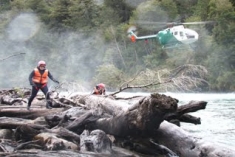Open Season on Patagonia's Rivers Takes Three Workers Lives
With "open season" declared on Patagonia's rivers, the costs and risks of building dams in Patagonia are now fatally apparent.
On September 1, a Zodiac raft carrying 5 men working for Energía Austral (a subsidiary of the Swiss mining giant Xstrata) turned over in the Río Cuervo, where Energía Austral currently proposes to build a 640 MW dam. Of those 5 men, two managed to get to shore with their lives. The three others, Moisés Aros Salgado, Mario Méndez Maldonado, and Edgardo Rogel Arteaga, have not been seen since they were swept away in the white water of the torrential Patagonia flow of the Cuervo.
If you are wondering why you have not heard about this tragedy previously, relatives of the disappeared men have denounced the information blockade on the accident. Considering the prominence of dam building and energy development issues in Chilean society, the absence of more transparent reporting on how three men have been lost in a remote wild river while working for a multi-national corporation that wants to build a dam on that river is a grim indicator of a corporate controlled media. Though there has been mention of the issue in the mainstream Chilean press, many questions remain unasked, much less answered.
For instance--if Xstrata/Energía Austral submitted their Río Cuervo project EIA documents in early August 2009 (it has been determined that the period of public comment will legally close on November 23), what were they doing with workers on the river on the first day of September? What tools did the crew have with them, what was their technical objective, and why were they in the field if the project has not been legally approved? Were they provided the appropriate safety gear and training for being on a wild river pumping with winter run-off?
Though there were no deaths, does it provide more reason to ask what HidroAysén was doing blasting in the field during the last austral summer? How can these companies carry out field work on risky hydroelectric mega projects when they have not completed the environmental review process?
Is it even necessary that people risk their lives to build dams on Patagonia's rivers when so many alternatives are available?
It is important to keep asking what happened that day when the Energía Austral Zodiac dumped into the Río Cuervo, and to think about what it means for the Chilean people, and for Patagonia. People are now literally dying in the "open season" that has been declared on Patagonia's rivers. It is total free market corporate chaos--dams are being evaluated for construction without transmission lines being considered, ill-acquired water rights are being quietyly traded, projects are being secretely proposed through out the region, and, apparently, workers lives can be lost without much information or investigation.
UPDATE: According to an article published in the Coyhaique newspaper El Divisadero, the Puerto Aysén volunteer fire department search personnel have called off their search for the bodies, saying that this is not just a job for volunteers, and that the Carabineros (Chile's National Police) and the central governments primary emergency and technical rescue force need to pick up the slack and dedicate some real resources to finding the bodies of the lost men.
Other than this piece of local news, the information blockade on this accident continues.
Interestingly enough, speaking of dissapeared men, a suit filed against Energía Austral for the illegal cutting of native forest has been postponed another month because the Chilean courts cannot locate the offices of the company in order to deliver the summons to the company executives! Problem is, though, that we know the executives of the Energía Austral are alive and well (though working in clandestine conditions?), while the men who were working on the Río Cuervo are not that fortunate.



